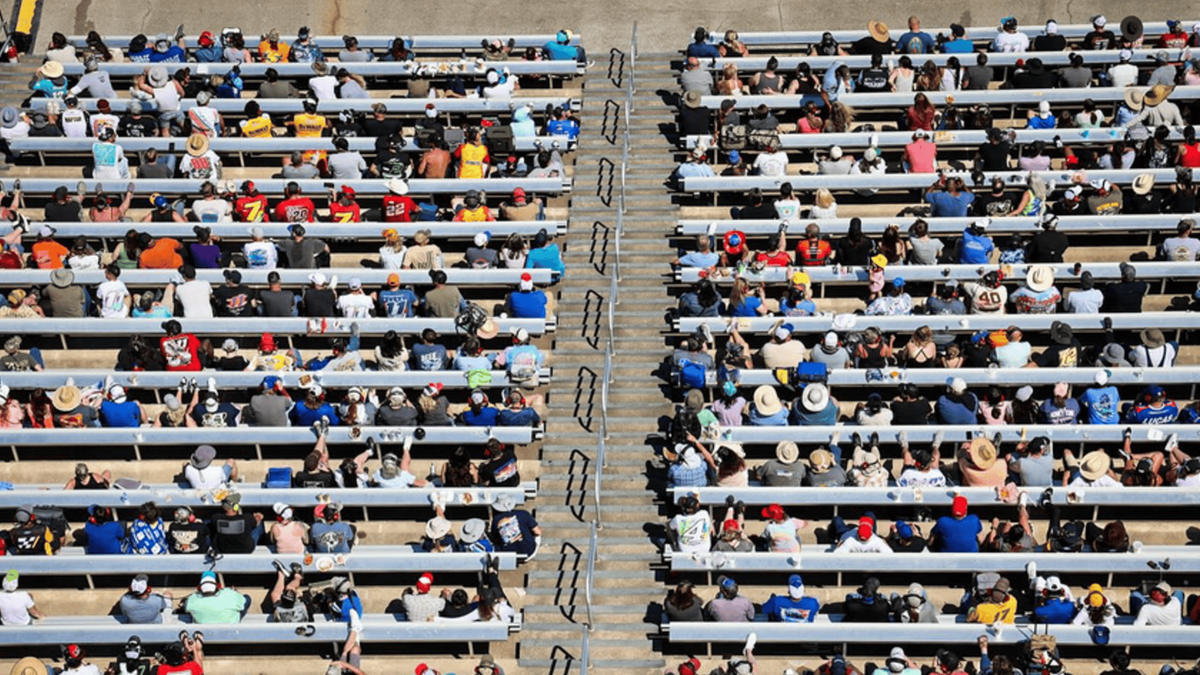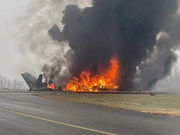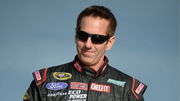

The Texas Motor Speedway hummed with the raw energy of 38 race cars charging into the Autotrader EchoPark Automotive 400, a 267-lap showdown that promised NASCAR at its finest—drivers battling door-to-door, fans roaring, and a finish to spark endless debates. Instead, Joey Logano’s win, secured by a 0.346-second margin after leading just seven laps, became a flash point for a fanbase exasperated by a race marred by 16 cautions, pit-stop gambles, and a Next Gen car that’s choking the sport’s spirit.
Watch What’s Trending Now!
The ratings painted a picture of success: Jayski reported 2.56 million views on FS1, edging out Formula 1’s Miami Grand Prix at 2.103 million. Logano’s victory was hailed as a ratings triumph, outshining other sports broadcasts. But social media fans didn’t sing the same tune. The numbers hid a harsh reality—fans weren’t buzzing with excitement; they were venting about a race that prioritized strategy over skill, with pit stops and yellow flags overshadowing on-track action.
ADVERTISEMENT
Poll results reveal a worrying ground-level trend
The race was a chaotic mess of interruptions and strategy calls. With 12 cautions over 73 yellow flag laps and 20 lead changes among 13 drivers, it had moments of drama—Kyle Larson’s 90-lap lead and Stage 2 win, Josh Berry’s 35-lap stint, and Michael McDowell’s crash on lap 254. But yellow flags, like Denny Hamlin’s engine fire on lap 75, Josh Berry’s spin on lap 125, or Bubba Wallace’s crash on lap 172 that ensnared AJ Allmendinger and Alex Bowman, shattered any rhythm.
Pit stops dictated the outcome: Logano’s two-tire stop on lap 220, clocking 4.48 seconds, set up his win, while Ryan Blaney climbed from 24th to second without leading a lap, relying on restarts and pit calls. William Byron’s pit-road contact with Cole Custer on lap 167 and Riley Herbst’s uncontrolled tire penalty underscored the pit-lane drama.
Taking to X, Jeff Gluck wrote, “Was Texas a good race? 50.7% of you said Yes. — Ranks No. 8 of 17 Texas races in the poll — Ranks No. 18 of 26 Joey Logano wins in the poll — Season started with seven straight races of 68%+ ratings (including six over 77%). Now there have been five straight under 51%.” Gluck’s ‘Was It a Good Race?’ poll, a fan-favorite barometer, delivered a devastating blow. This is a “worrying trend,” as five of the season’s first ten races scored below 50% approval.
ADVERTISEMENT
Was Texas a good race? 50.7% of you said Yes.
— Ranks No. 8 of 17 Texas races in the poll
— Ranks No. 18 of 26 Joey Logano wins in the poll
— Season started with seven straight races of 68%+ ratings (including six over 77%). Now there have been five straight under 51%
— Jeff Gluck (@jeff_gluck) May 6, 2025
“They have a low morale right now due to their lack of faith in the competition leadership,” Denny Hamlin voiced a sentiment fans echoed across platforms. Hamlin, a three-time Daytona 500 winner, tore into NASCAR’s leadership in an interview after the Talladega race from last week: “I just think that NASCAR created its own stats to make itself look good… You’re just making something up to look better.” Hamlin also pinpointed the car’s aerodynamic flaws, which create “dirty air” that stalls trailing cars, making passing nearly impossible without cautions or pit stops.
ADVERTISEMENT
“I just know how this sport works,” Joey Logano said after the race. “That’s why you got to just brush some stuff off. Last week, did it suck? Yeah. It’s a long week, but you know that next Sunday presents the opportunity for redemption. We did that today.” NASCAR’s own analysis framed Logano’s win as a story of redemption, noting his recovery from a 27th-place start and a recent slump. Logano’s strategic prowess, with his “late-race two-tire call that vaulted him to the lead” and his ability to hold off Blaney in the final laps. Yet, this narrative of triumph clashed with fans’ experience, who saw a race won not by driver skill but by pit strategy and caution luck, further fueling their discontent.
The fan reactions are a visceral outcry from a community at its breaking point.
Top Stories
Greg Biffle Plane Tragedy: What Might Have Caused the Crash That Killed the NASCAR Champ and His Family

“The Biff”: NASCAR Fans Push for Legacy-Defining Award Named After Greg Biffle Following His Tragic Death

Footage Surfaces of Florida Police Arresting NASCAR Veteran Over Disturbing Public Misbehavior

Who Is Greg Biffle’s Wife? Everything You Need to Know About Cristina Grossu

Richard Childress’ Grandson to Be the ‘First Casualty’ of RCR-Kaulig Racing Divorce, Claims Dale Jr.

ADVERTISEMENT
Fans agree with what the poll revealed
“I voted no due to the high number of cautions & overtime. Those 2 things will kill any race for me,” one fan wrote on Gluck’s X post. The 12 cautions, detailed by On3, turned Texas into a stop-start ordeal, with incidents like Chris Buescher’s tire blowout on lap 161 or the lap 172 pileup disrupting flow. Media outlets called it “weird, wild,” but fans saw chaos, not competition. The race’s aforementioned caution, stretching over 73 laps—nearly a quarter of the event—killed momentum. “It was a wreck-fest, not a race,” one commenter lamented, longing for the clean, wheel-to-wheel battles of NASCAR’s past, when drivers like Jeff Gordon or Tony Stewart defined races through bold overtakes.
“Couldn’t pass so makes sense why it was so low. NASCAR needs to fix this aero problem,” another X user posted. The Next Gen car’s aerodynamic issues create turbulent air that stalls trailing cars, making passing a rarity. Hamlin elaborated: “The car’s design forces you to wait for a mistake or a caution. That’s not what fans want.” Key moments, like Larson’s lead grab on lap 190, Ty Gibbs’ move to second on lap 191, or Ryan Blaney’s three-wide pass on lap 183, relied on restarts or errors, not raw speed. With only 15 lead changes despite 11 drivers leading, the race lacked the fluidity fans crave, a far cry from battles like Larson’s challenge on Austin Cindric on lap 188.
“The fact so many wildcards were in contention helped a lot,” one fan noted, clinging to a bright spot. Chase Briscoe, Ty Gibbs, and John H. Nemechek, who led on lap 221 after starting 28th. Gibbs, second on lap 191, and McDowell, leading on lap 251 with a best lap of 28.799 seconds, gave underdog fans hope. NASCAR.com praised the “unlikely contenders” like Nemechek, who “showed the depth of the field.” But comments showed it wasn’t enough: “Wildcards were cool, but the racing was boring,” one fan wrote. Another vented, “We’ve lost the plot,” slamming NASCAR’s parity-driven approach. The spark of Larson’s 186 top-five laps or Berry’s 98 top-10 laps was dimmed by a race that dragged, with pit stops stealing the show.
ADVERTISEMENT
“I wonder when nascar is going to ask you to stop doing these polls,” a user quipped to Gluck. It’s a jab with weight—Gluck’s polls are a megaphone for fan frustration.
“I know strategy is part of racing, but all the passing is in the pits. 2 tires 4 tires saving fuel. The best car hardly wins anymore. To be honest, this car sucks. So strategy is the only way to pass,” another fan vented. Pit strategies shaped Texas: Cindric’s two-tire stop on lap 22 secured Stage 1, Larson’s quick pit on lap 127, and Blaney’s restart-fueled climb defined their runs. Penalties, like McDowell’s speeding on lap 127, and incidents, like Byron’s contact with Custer, underscored the pit-lane focus. Logano’s 42 points, earned through a two-tire call, not track dominance, left fans cold, despite all the praise.
The NASCAR community is uniting—not against the sport they’ve cherished for generations, but against a version that feels sterile. And Texas was a breaking point. Fans are done with excuses—they want their sport back, and they’re ready to fight for it.
ADVERTISEMENT
ADVERTISEMENT
ADVERTISEMENT
ADVERTISEMENT

